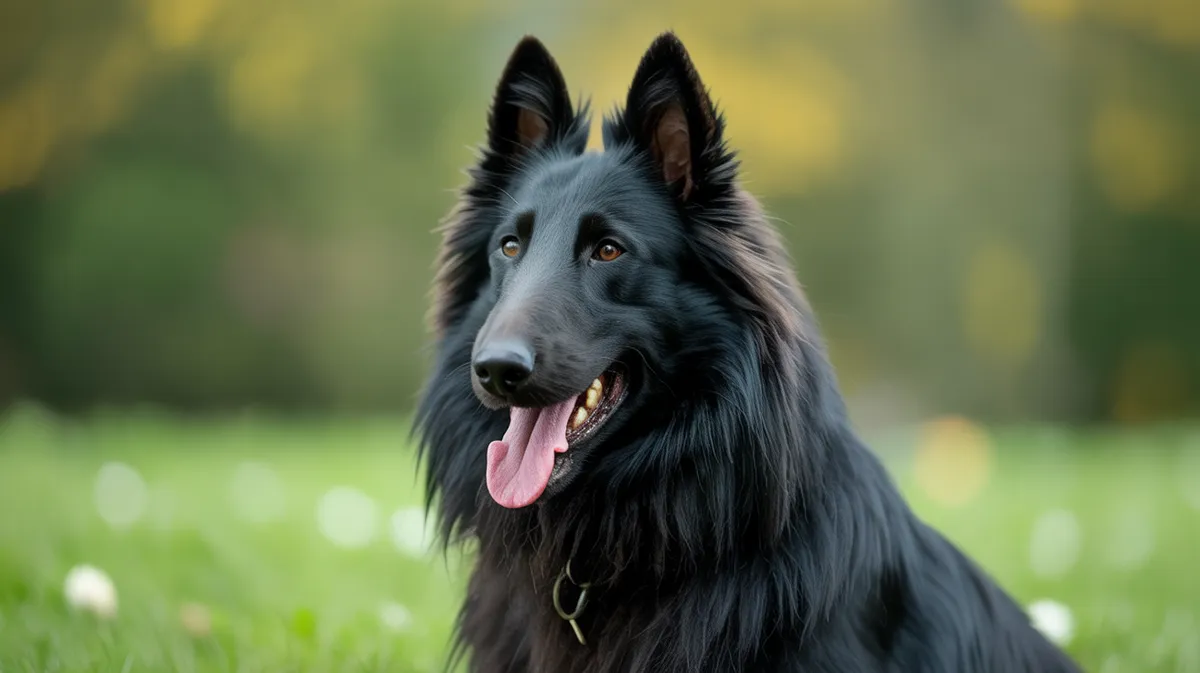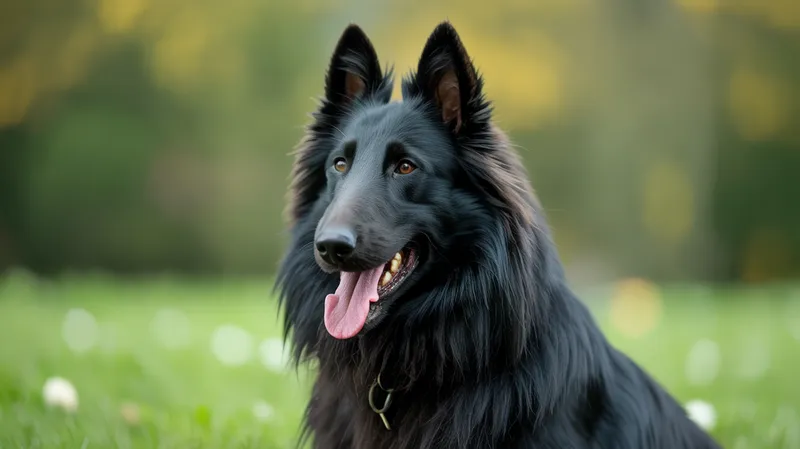
Belgian Sheepdog (Groenendael)
Canis lupus familiaris

Meet the Belgian Sheepdog (Groenendael)
The Belgian Sheepdog (Groenendael) is a highly intelligent and energetic herding breed known for its striking all-black, long, double coat. Originally developed in Belgium for sheep herding and farm work, the Groenendael is both an agile working dog and a loyal family companion. It is renowned for its trainability, protective instincts, and versatility, excelling in police, search and rescue, and competitive dog sports. Groenendaels are alert, social, and require significant mental and physical stimulation to thrive. This breed forms strong bonds with its owners and is known for being both affectionate and vigilant.
Classification
Mammal
Habitat
Domesticated; often found in rural, suburban, and urban environments with access to open spaces or farms
Diet
Omnivore
Lifespan
10-14 years
Conservation
Least Concern
Weight
27-34 kg (60-75 lbs)
📖Fascinating Facts
Versatile Worker
The Belgian Sheepdog has served in roles ranging from herding livestock to working as a police, military, and search-and-rescue dog worldwide.
Signature Black Coat
Unlike other Belgian breeds, the Groenendael is recognized by its long, solid black double coat, which requires regular grooming.
High Energy
This breed is highly energetic and needs daily physical and mental stimulation to prevent boredom and behavioral issues.
📋Detailed Description
The Belgian Sheepdog (Groenendael) is a medium-to-large herding breed, typically standing 56–66 cm (22–26 in) at the shoulder and weighing 27–34 kg (60–75 lbs). Its most distinguishing feature is its dense, long, double-layered black coat, which provides insulation and protection in harsh weather. The breed is characterized by a well-proportioned, athletic build, erect triangular ears, and a pronounced ruff around the neck. Groenendaels possess a keen, intelligent expression, reflecting their high cognitive abilities. They are highly energetic and require extensive daily exercise and mental stimulation. Socially, they are known for their strong attachment to their human families and can be reserved or aloof with strangers, making them excellent watchdogs. Their herding ancestry manifests in their instinct to control movement, sometimes herding children or other animals. The breed is highly trainable and excels in obedience, agility, and protection sports. Anatomically, they have a deep chest, strong limbs, and a bushy tail, all contributing to their agility and endurance. Groenendaels are also known for their longevity, with a typical lifespan of 12–14 years, and are generally robust, though prone to certain hereditary conditions such as hip dysplasia and epilepsy.
💡 Did you know?
Despite their wolf-like appearance, Belgian Sheepdogs are extremely gentle and thrive on human companionship, making them excellent family pets.
🔬Research & Sources
🎭Behavior & Social Structure
Belgian Sheepdogs are alert, responsive, and display a high degree of trainability and problem-solving ability. They thrive on structured routines and tasks, often seeking out work or play that challenges their intelligence. As herding dogs, they may exhibit chasing or circling behaviors, especially when excited. Their feeding behavior is typical of domestic dogs, with a preference for high-protein diets; they may display food-guarding tendencies if not properly socialized. Socially, they form tight bonds with their primary caregivers and can be protective, sometimes wary of unfamiliar people or animals. Daily routines should include vigorous exercise, such as running, agility training, or advanced obedience work, to prevent boredom and the development of destructive behaviors. They are sensitive to their environment and respond well to positive reinforcement training methods. Groenendaels are also known for their vocalizations, using barks and other sounds to communicate alertness or excitement.
👶Reproduction & Life Cycle
The Belgian Sheepdog reaches sexual maturity between 9 and 12 months, though responsible breeding is recommended after 2 years of age. Females typically come into estrus twice yearly. Mating is usually managed by breeders to ensure genetic health and temperament. The gestation period averages 63 days, after which litters of 6–10 puppies are common. Parental care is primarily provided by the dam, who nurses and grooms the puppies for the first 3–4 weeks. Puppies are weaned by 6–8 weeks and begin socialization and basic training soon after. Early exposure to various stimuli is crucial for proper behavioral development. Breeding programs often include genetic screening to minimize the risk of inherited disorders.
🛡️Adaptations & Survival
The Groenendael's thick double coat is an adaptation to the variable Belgian climate, offering protection from cold, rain, and minor abrasions. Their athletic physique, with well-developed musculature and a deep chest, supports endurance and agility needed for herding and protection work. Behavioral adaptations include heightened vigilance, rapid learning, and a strong work drive, all selected for in their herding and guarding roles. Their acute senses of hearing and smell are well-developed, aiding in detection and response to environmental cues. The breed's social intelligence allows it to interpret human commands and emotions effectively, making them versatile working and companion animals.
📚Research Sources
🎨Cultural Significance
The Belgian Sheepdog (Groenendael) holds a prominent place in Belgian national heritage, recognized as one of four native Belgian herding breeds. Historically, they were integral to rural life, managing livestock and guarding property. In the 20th century, their intelligence and trainability led to widespread use in police, military, and search-and-rescue roles across Europe and North America. Groenendaels have appeared in literature and film as symbols of loyalty, courage, and intelligence. Breed clubs and enthusiasts celebrate the Groenendael in working trials and dog sports, maintaining its reputation as a versatile and noble working dog.
🔬Recent Research & Discoveries
Recent genetic studies have focused on the population structure and diversity of Belgian Shepherd varieties, highlighting the importance of maintaining genetic health through responsible breeding. Ongoing research investigates the breed's susceptibility to neurological disorders, particularly epilepsy, with efforts to identify associated genetic markers. Behavioral research underscores the Groenendael's advanced problem-solving abilities and suitability for complex working roles, including detection and assistance tasks. Studies on canine cognition have used the breed to explore social learning and communication with humans. There is also active research into optimizing training protocols for working Belgian Sheepdogs in law enforcement and search-and-rescue contexts.
🎥Wildlife Videos

GROENENDAEL BELGIAN SHEEPDOG ALL ABOUT HERDING
Please support the Channel by checking out my affiliate links!!! Become a Dogumentary TV Channel member!!!
Dogumentary TV

Belgian shepherd Groenendael
Are Belgian shepherd Groenendael dangerous? Yes! If you don't play with them. #belgianshepherd #groenendael #blackdog ...
Omen Groenendael

Belgian Sheepdogs are never far from their family! #dogs #sheepdog #watchdogs
Scooter in the Sticks

The Gang of Belgians coming up💥💥💥. Belgian Shepherd Groenendael with KCI, Kerala.
JustSheps

Belgian sheepdog always has its secrets #belgianshepherd #groenendael #dogs #belgiansheepdog
Omen Groenendael

Nature dog #belgianshepherd #blackdog #groenendael
Omen Groenendael
🌍Habitat Information
The Belgian Sheepdog (Groenendael) typically inhabits Domesticated; often found in rural, suburban, and urban environments with access to open spaces or farms environments. Belgian Sheepdog (Groenendael)s have adapted to their environments with specialized features and behaviors.
Primary Habitat:
Domesticated; often found in rural, suburban, and urban environments with access to open spaces or farms
More detailed habitat information will be available soon.
🛡️Conservation Status
The Belgian Sheepdog (Groenendael) is currently classified as Least Concern. Conservation efforts are crucial for preserving this species for future generations.
Common Threats:
- 🏠Habitat loss and fragmentation
- 🌡️Climate change impacts
- 🎯Hunting and poaching
- 🏭Human-wildlife conflict
⚠️Threats & Conservation Challenges
As a domesticated breed, the Belgian Sheepdog does not face natural predation threats, but is subject to challenges common to pedigree dogs. These include genetic bottlenecks due to selective breeding, leading to increased incidence of hereditary diseases such as hip dysplasia, epilepsy, and progressive retinal atrophy. Inadequate exercise or mental stimulation can result in behavioral problems, including anxiety and destructiveness. Overpopulation and irresponsible breeding can contribute to abandonment or sheltering, though the breed is less common than some others. There are no significant conservation concerns, but breed clubs and registries emphasize responsible ownership and genetic health monitoring.
🔬Scientific Classification
Scientific Name
Canis lupus familiaris
Classification Hierarchy
🔍 About Taxonomic Classification
Taxonomic classification is a hierarchical system used by scientists to classify and organize living organisms based on shared characteristics and evolutionary relationships.
The system moves from broad categories (Kingdom) to increasingly specific ones, with each animal's scientific name typically consisting of its Genus and species.
📝Community Notes
Share your observations and insights about the Belgian Sheepdog (Groenendael) with our community of wildlife enthusiasts.
Join Our Community
Sign in to share your observations and connect with fellow wildlife enthusiasts.
Sign In to ContributeNo community notes yet
Be the first to share your observations about the Belgian Sheepdog (Groenendael)!
Explore Belgian Sheepdog (Groenendael)
Select a tab above to learn more about this amazing animal.
📸Photo Gallery
No photos available for this animal yet.
🌟Discover More Wildlife
Continue your journey of discovery with more fascinating animals from our database
